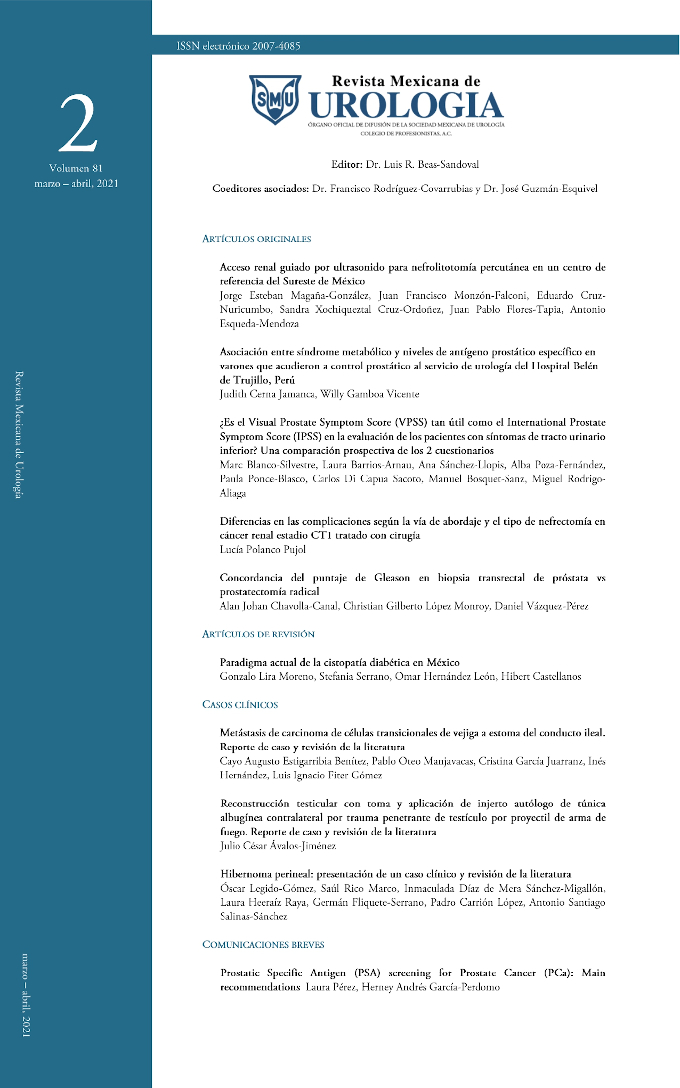Is the Visual Prostate Symptom Score (VPSS) as useful as the International Prostate Symptom Score (IPSS) in evaluating patients with lower urinary tract symptoms (LUTS)? A prospective comparison of the 2 questionnaires.
DOI:
https://doi.org/10.48193/revistamexicanadeurologa.v81i2.666Keywords:
Key words: Visual Prostate Symptom Score (VPSS), International Prostate Symptom Score (IPSS), lower urinary tract symptoms (LUTS), benign prostatic hyperplasia (BPH).Abstract
Introduction: The symptoms of the lower urinary tract (LUTS) are one of the main reasons for consultation in urology. The International Prostate Symptom Score (IPSS) is a useful tool in the assessment of LUTS, but in daily clinical practice it is not always easy for all patients to complete it.
Objective: To check if there is an adequate correlation between the Visual Prostate Symptom Score (VPSS) and the IPSS in the diagnosis of patients with LUTS and to evaluate the differences regarding the need for help and the time required for self-completion of both questionnaires.
Material and methods: A prospective, multicenter study was conducted from June 2019 to January 2020. Both questionnaires were delivered to patients for self-completion in the Urology clinic. Later, in the same clinic, flowmetry and prostate ultrasound were performed. Variables were analyzed: age, IPSS score, VPSS score, need for help completing the questionnaires, time spent, maximum flow (Qmax), prostate volume and educational level. Spearman's correlation coefficient was used for statistical analysis.
Results: A total of 101 patients with LUTS were collected. The mean age was 68'53 years. The maximum flow was 9.2 ml/s on average and the prostatic volume was 50.77 cc on average. The level of studies was: primary studies in 49'5% of patients, secondary 20'8%, vocational training 13'8% and university studies 7'9%. A negative correlation was observed between the total IPSS score and the VPPS with the Qmax. The time required and the need for help were greater for completing the IPPS than for the VPSS, these differences being statistically significant. Patients with primary studies required less time and help to complete the VPPS.
Conclusions: VPSS is correlated with IPSS, with the advantage of being easier and faster to complete by patients.
References
Barry MJ, Fowler FJ, O’Leary MP, Bruskewitz RC, Holtgrewe HL, Mebust WK, et al. The American Urological Association symptom index for benign prostatic hyperplasia. The Measurement Committee of the American Urological Association. J Urol. 1992;148(5):1549–57; discussion 1564. doi: 10.1016/s0022-5347(17)36966-5
Martin SA, Haren MT, Marshall VR, Lange K, Wittert GA, Members of the Florey Adelaide Male Ageing Study. Prevalence and factors associated with uncomplicated storage and voiding lower urinary tract symptoms in community-dwelling Australian men. World J Urol. 2011;29(2):179–84. doi: 10.1007/s00345-010-0605-8
Novara G, Galfano A, Gardi M, Ficarra V, Boccon-Gibod L, Artibani W. Critical Review of Guidelines for BPH Diagnosis and Treatment Strategy. European Urology Supplements. 2006 Apr 1;5(4):418–29. doi: https://doi.org/10.1016/j.eursup.2006.02.005
Gravas S, Cornu JN, Gacci M, Gratzke TRW, Herrmann C, Mamoulakis, M, et al. Management of Non-neurogenic Male LUTS. EAU Annual Congress. España; 2019.
Netto Júnior NR, de Lima ML. The influence of patient education level on the International Prostatic Symptom Score. J Urol. 1995;154(1):97–9. doi: 10.1097/00005392-199507000-00034
Chapple CR, Wein AJ, Abrams P, Dmochowski RR, Giuliano F, Kaplan SA, et al. Lower urinary tract symptoms revisited: a broader clinical perspective. Eur Urol. 2008;54(3):563–9. doi: 10.1016/j.eururo.2008.03.109
Heyns CF, van der Walt CLE, Groeneveld AE. Correlation between a new visual prostate symptom score (VPSS) and uroflowmetry parameters in men with lower urinary tract symptoms. S Afr Med J. 2012;102(4):237–40.
D’Silva KA, Dahm P, Wong CL. Does this man with lower urinary tract symptoms have bladder outlet obstruction?: The Rational Clinical Examination: a systematic review. JAMA. 2014;312(5):535–42. doi: 10.1001/jama.2014.5555
Rodrigues Netto N, de Lima ML, de Andrade EF, Apuzzo F, da Silva MB, Davidzon IM, et al. Latin American study on patient acceptance of the International Prostate Symptom Score (IPSS) in the evaluation of symptomatic benign prostatic hyperplasia. Urology. 1997;49(1):46–9. doi: 10.1016/s0090-4295(96)00372-x
Luján Galán M, Páez Borda A, Martín Osés E, Llanes González L, Berenguer Sánchez A. The validity of the IPSS questionnaire in a sample of 262 patients with benign prostatic hyperplasia. Arch Esp Urol. 1997;50(8):847–53.
Ceylan Y, Gunlusoy B, Degirmenci T, Kozacioglu Z, Bolat D, Minareci S. Is new visual prostate symptom score useful as International Prostate Symptom Score in the evaluation of men with lower urinary tract symptoms? A prospective comparison of 2 symptom scores in Turkish society. Urology. 2015;85(3):653–7. doi: 10.1016/j.urology.2014.10.057
Afriansyah A, Gani YI, Nusali H. Comparison between visual prostate symptom score and international prostate symptom score in males older than 40 years in rural Indonesia. Prostate Int. 2014 Dec;2(4):176–81. doi: 10.12954/PI.14059
Heyns CF, Steenkamp BA, Chiswo J, Stellmacher GA, Förtsch HEA, Van der Merwe A. Evaluation of the visual prostate symptom score in a male population with great language diversity and limited education: a study from Namibia. S Afr Med J. 2014;104(5):353–7. doi: 10.7196/samj.7917
Park YW, Lee JH. Correlation Between the Visual Prostate Symptom Score and International Prostate Symptom Score in Patients With Lower Urinary Tract Symptoms. Int Neurourol J. 2014;18(1):37–41. doi: 10.5213/inj.2014.18.1.37
Taneja Y, Ram P, Kumar S, Raj K, Singh CK, Dhaked SK, et al. Comparison of Visual Prostate Symptom Score and International Prostate Symptom Score in the evaluation of men with benign prostatic hyperplasia: A prospective study from an Indian population. Prostate Int. 2017;5(4):158–61. doi: 10.1016/j.prnil.2017.04.004






